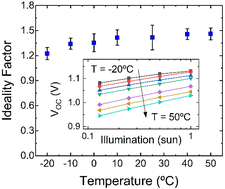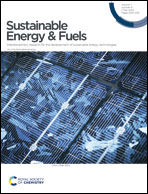Highly stable CsFAPbIBr perovskite solar cells with dominant bulk recombination at real operating temperatures
Abstract
Mixed-cation mixed-halide perovskite solar cells have been characterized in DC at different temperatures (from −20 °C up to 50 °C) and the time evolution of the device efficiency has been assessed using different degradation protocols (indoors and outdoors). The completely planar p–i–n structure is ITO/CuNiOx/PTAA/CsFAPbIBr/PCBM/PEI/Ag. Pristine current–voltage characteristics barely show hysteresis, at any temperature. Open circuit voltage decreases with temperature at a rate of −1.5 mV °C−1, and the obtained PCE temperature coefficient is lower than −0.001% K−1, which is an outstanding value for this emerging photovoltaic technology. Cells have been degraded under different protocols: indoors using different light/dark cycles and outdoors in a high temperature and high irradiation location. Cells show no significant decrease of the efficiency after more than 350 h of indoor light cycling and the estimated T80 obtained for the sample degraded outdoors under high irradiation and high temperature conditions is ∼15 days.

- This article is part of the themed collection: Hybrid, Organic and Perovskite Photovoltaics Stability


 Please wait while we load your content...
Please wait while we load your content...